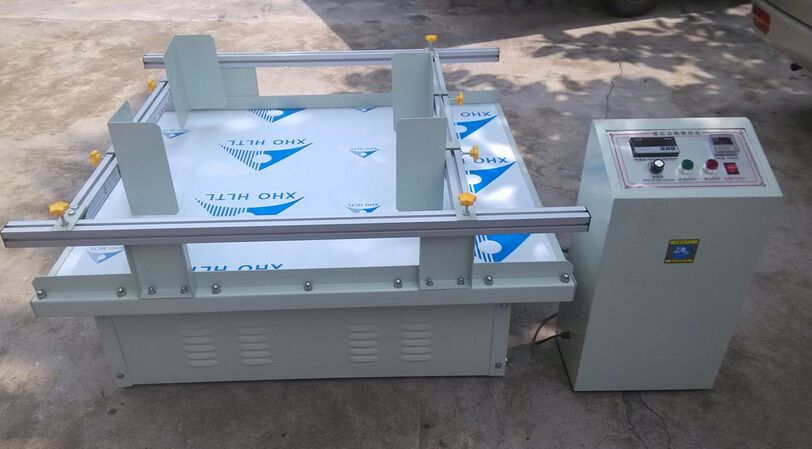ISO 13355-12 Combined Random and Sine Vibration
The ISO 13355-12 standard is a comprehensive guide for conducting combined random and sine vibration testing, which simulates the complex stress environments that packages may experience during transportation. This type of testing is essential for ensuring the durability and integrity of packaging materials under various dynamic conditions, thereby safeguarding product quality throughout distribution.
The primary objective of this test is to evaluate how well a package can withstand a combination of random vibrations and sine wave excitations. These forces mimic real-world scenarios such as road roughness, mechanical handling, and vehicle acceleration during transit. By subjecting the packaging to these conditions, manufacturers can identify potential weaknesses before product launch.
The test setup involves placing the package on a vibration test rig that can produce both random and sine wave vibrations simultaneously. The frequency range for sine waves typically spans from 10 Hz up to 250 Hz or higher, depending on the specific requirements outlined in ISO 13355-12. Random vibrations are generated within this same frequency band but with varying peak amplitudes.
During testing, the package must be secured properly using appropriate fixtures designed specifically for the type of packaging being tested. It is crucial to ensure that all test parameters align closely with those specified in ISO 13355-12 to maintain consistency and reproducibility across different trials.
The duration of each test phase (random vs sine) can vary based on the intended use case for the package; however, typically it lasts between several minutes to over an hour per phase. After completing both phases, inspectors examine any visible damage or deformation in the packaging structure and contents.
Compliance with ISO 13355-12 ensures that packaging meets international standards regarding robustness and safety during shipping processes. This certification is particularly important for industries like pharmaceuticals, electronics manufacturing, and consumer goods where maintaining product integrity throughout logistics chains is paramount.
In summary, combined random and sine vibration testing per ISO 13355-12 provides valuable insights into a package’s ability to endure challenging transportation conditions without compromising on its protective capabilities. For organizations aiming to enhance their supply chain efficiency while ensuring product safety at every stage of delivery, this service offers an indispensable tool.
Why It Matters
The significance of ISO 13355-12 combined random and sine vibration testing cannot be overstated in today’s globalized market. As products traverse international borders through diverse climates and terrains, their packaging must endure a wide array of environmental challenges.
- Enhanced Product Protection: Properly designed packages can protect fragile goods from damage caused by rough handling or harsh weather conditions encountered during transport.
- Better Consumer Trust: Packages that pass rigorous testing build trust among consumers, who expect safe and undamaged products upon receipt.
- Cost Savings: Preventing product spoilage reduces waste and associated costs for manufacturers. Moreover, compliant packaging can help avoid costly recalls due to quality issues arising from improper protection during transit.
- Regulatory Compliance: Many countries require compliance with international standards like ISO 13355-12 when importing or exporting goods. Non-compliance can lead to penalties and delays at customs checkpoints.
The results of this testing not only enhance product safety but also contribute significantly towards improving overall supply chain performance by reducing risks associated with improper packaging practices.
International Acceptance and Recognition
- Australia: Australia’s National Standards (AS/NZS) align closely with ISO standards, including those related to packaging. Therefore, compliance with ISO 13355-12 is widely accepted in this region.
- European Union: The EU has harmonized many of its regulations with international standards like ISO. Thus, packages meeting these criteria are recognized across all member states and beyond.
- United States: While the US does not adopt every ISO standard directly into its own codes, it often adopts them through reference or incorporation by reference in its regulations. Compliance here can be advantageous for global businesses operating within this market.
- Japan: Japan also aligns much of its national technical standards with those set forth internationally, making compliance with ISO 13355-12 beneficial for companies looking to penetrate the Japanese market.
The widespread acceptance and recognition ensure that packages tested according to this standard remain compatible across multiple jurisdictions, facilitating smoother international trade operations.
Competitive Advantage and Market Impact
By embracing ISO 13355-12 combined random and sine vibration testing, companies can gain several competitive advantages. Firstly, they demonstrate a commitment to excellence in product protection, which resonates positively with customers seeking quality assurance.
Secondly, successful completion of this test enhances brand reputation by showing that products are prepared for the rigors of global shipping networks. This perception translates into increased market share and customer loyalty.
In addition, meeting these stringent standards can open doors to new markets where regulatory compliance is crucial. For instance, companies seeking entry into emerging economies may find it easier if they already have certifications aligned with internationally recognized practices such as ISO 13355-12.
Moreover, the data generated from these tests provides actionable insights that can drive continuous improvement in packaging design and materials selection. Such enhancements lead to more efficient supply chains capable of handling diverse conditions efficiently.
The strategic implementation of this testing protocol thus contributes significantly towards strengthening a company’s position within competitive landscapes characterized by increasing globalization and heightened consumer expectations regarding product safety and integrity.





